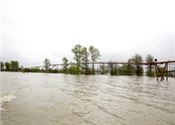|
Continued Flooding Keeps Farmland Out Of Production
VICKSBURG, MISS.
Although numbers on paper look about right for Mississippi row crops, the reality is actually quite grim in places.
Flooding in areas along the Mississippi River and its tributaries is affecting hundreds of thousands of acres of farmland nationally. In Mississippi, the south Delta is hardest hit, with an estimated 200,000 acres impacted by flooding in late June.
Josh Maples, agricultural economist with the Mississippi State University Extension Service, said farmland still under water likely won’t be planted at all this year. Another significant chunk of acreage has only recently been planted. Other fields had total losses after initial plantings and have been replanted.
“It is still too early to know the full economic impact because we don’t yet know the planting totals or the potential yield impacts,” Maples said.
The U.S. Department of Agriculture gives a weekly update on the crop status in the state. As of June 16, USDA showed corn, cotton, peanuts, rice, sorghum and soybeans either completely planted or only slightly behind the five-year average planting rate. But these numbers don’t take into account the acreage that will not be planted in 2019.
Curt Lacy, an agricultural economist and Delta region Extension coordinator located at the Delta Research and Extension Center in Stoneville, provided some perspective on lost acreage.
Sharkey and Issaquena counties in the south Delta are the hardest hit by flooding.
USDA indicated in March that farmers in Sharkey County intended to plant 126,200 acres of corn, cotton and soybeans. Issaquena County farmers intended to plant 84,900 acres of these three crops. Last year, these counties actually harvested 125,200 and 82,800 acres, respectively, of corn, cotton and soybeans.
Persistent flooding since those planting intentions were stated changed everything.
“Estimates are that between 40 percent and 60 percent of the farmland in Sharkey County and 60 percent and 75 percent of the farmland in Issaquena County won’t be planted at all this year because it is still under water,” Lacy said.
In all, Mississippi plants about 3.3 million acres of corn, cotton and soybeans each year.
Soybeans have the distinction of being the crop with the best chance of a good performance even when planted late. With more than 2 million acres planted annually in Mississippi, soybean is a significant crop for the state.
Trent Irby, Extension soybean specialist, said the number of soybean acres will be down this year. It is too soon to speculate on outcomes.
“Late-planted soybeans often face major challenges from hot, dry summer weather patterns as well as late-season insect and disease pressure when compared to earlier planting dates,” Irby said. “A specific concern for this year is the possibility for increased management inputs for redbanded stink bug.”
Although Mississippians recognize that this spring was one of the wettest on record, rainfall was only a small part of the current disaster. The problem is Mississippi River flooding -- caused by snow melt and massive rainfall upriver -- that triggered closure of levees that typically drain Mississippi farmland.
Tom Ball, an Extension emergency coordinating officer, said there are 540,000 acres of Mississippi cropland behind the closed gates of the Steele Bayou Control Structure in Warren County. Much of this land is flooded, but opening the gates would make things worse.
John Elfer, Warren County Emergency Management Agency director, said the Mississippi River/Yazoo River side is higher than the backwater.
“If you open the gates, then the water would go the wrong way,” Elfer said. “Until the river falls enough below the backwater stage, the gates cannot open.”
At about noon June 19, the river was a miniscule .04 foot higher than the backwater, and Elfer predicted the level would drop enough for the gates to open before the week is over.
Relief, however, won’t come quickly.
“You’re going to see a difference in about a month,” he said. “We’re at almost 98 feet on the backwater, and to get it to 90 feet will take a month.” ∆

The south Delta has been flooded for months, and relief is still weeks away once the flood gates are opened.
This pivot irrigation system stands in floodwater in Issaquena County in this April 5, 2019, photo.
Photo by MSU Extension Service/Michaela Parker
 Flooding is visible June 19, 2019, on both sides of this road about 1 mile east of the Steele Bayou Control Structure in Warren County, Mississippi.
Flooding is visible June 19, 2019, on both sides of this road about 1 mile east of the Steele Bayou Control Structure in Warren County, Mississippi.
On the left is backwater flooding, while on the right is Mississippi River water.
Photo by Warren County EMA/John Elfer
|
|